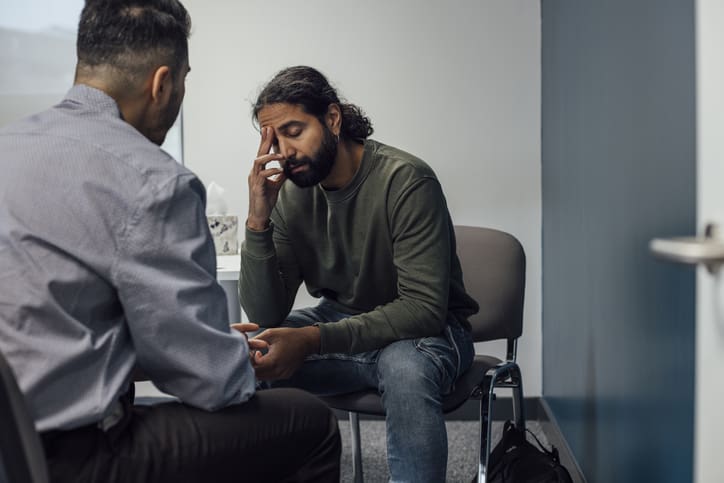Anxiety can feel like a persistent weight on your chest, but turning to alcohol or drugs to “take the edge off” comes at a cost. What starts as an attempt to self-medicate can create a cycle that worsens anxiety over time and leads to substance use disorder.
If you’ve noticed your anxiety is getting worse despite (or because of) drinking or drug use, this isn’t just your imagination—it’s your brain undergoing real changes. Understanding how substance use impacts the symptoms of an anxiety disorder is key to breaking the cycle and getting back to living the life you deserve.
The Anxiety-Substance Use Feedback Loop
The problem with self-medicating lies in what happens when the effects of the substance wear off. As alcohol or drugs leave your system, your brain struggles to regain balance. This cycle creates what’s called the anxiety-substance use feedback loop:
- You use substances to ease your anxiety.
- Being under the influence temporarily lowers your anxiety.
- As the substances wear off, your anxiety returns even stronger.
- You use drugs or alcohol again to find relief.
Over time, this spiral can turn occasional self-medication into dependency or addiction—trapping you in a cycle where neither the anxiety nor the substance use feels manageable.
How Substance Abuse Changes Your Brain
Substance abuse alters your brain’s chemistry and structure, especially when drugs and alcohol are being used to cope with the symptoms of an anxiety disorder.
- Disrupted Neurotransmitter Systems
Neurotransmitters are the chemical messengers in your brain that regulate mood, emotions, and behavior. Substances like alcohol, illegal drugs, or prescription medications often target:
- GABA (Gamma-Aminobutyric Acid). Known as the brain’s natural calming agent, GABA helps reduce anxiety. Substances like alcohol and benzodiazepines enhance GABA activity initially, creating a sense of relaxation. However, prolonged use can disrupt your brain’s ability to produce or regulate GABA naturally—leaving you more prone to anxiety and stress.
- Serotonin. This neurotransmitter is central to mood regulation. Substances like MDMA or certain antidepressants mimic or increase serotonin activity, but chronic misuse can deplete serotonin levels over time—leading to heightened anxiety and depression.
- Dopamine. Often referred to as the “reward chemical,” dopamine reinforces pleasurable behaviors, including substance use. Over time, the brain adjusts to elevated dopamine levels by reducing its natural production, leading to feelings of emptiness or increased anxiety when the substance is absent.
The disruption of these systems makes it harder for your brain to self-regulate—creating a dependency on external substances to feel “normal.”
- Overactive Stress Responses
Your amygdala, often called the brain’s fear center, plays a critical role in detecting and responding to threats. Chronic substance use overstimulates this area, making it hypersensitive to stress and anxiety triggers. This can cause:
- Exaggerated fear responses. Everyday challenges may feel overwhelming, as your brain perceives even minor stressors as significant threats.
- Increased panic and hypervigilance. You may find yourself on edge, unable to relax, and constantly anticipating danger, even in safe situations.
- Chronic stress hormone production. Substance use can lead to prolonged release of cortisol, the body’s primary stress hormone, which further damages the brain and body over time.
These changes make it increasingly difficult to break free from anxiety because your brain is wired to stay in a heightened state of alarm.
- Weakened Prefrontal Cortex
The prefrontal cortex (PFC) is the area of the brain responsible for rational thinking, decision-making, and impulse control. Long-term substance use can impair the PFC in several ways:
- Diminished impulse control. You may find it harder to resist urges to use substances, even when you know they’re harmful.
- Reduced problem-solving abilities. Anxiety and stress become harder to manage without substances because the PFC struggles to develop healthier coping strategies.
- Increased emotional reactivity. Without a fully functioning PFC to regulate emotions, you may experience heightened and overwhelming feelings of fear, anger, or sadness.
This impairment creates a vicious cycle: substances weaken the PFC, making it harder to resist use or regulate anxiety, which in turn perpetuates dependency.
What It Means to Have a Dual Diagnosis
When anxiety and substance use disorders occur together, they are considered a dual diagnosis. Here are some signs you might have a dual diagnosis:
- Feeling like you can’t manage your anxiety without drinking or using drugs.
- Needing more of a substance to feel the same effects.
- Experiencing withdrawal symptoms like restlessness, shaking, or panic when you stop using.
- Avoiding responsibilities or relationships because of anxiety or substance use.
- Feeling hopeless or trapped in a cycle of anxiety and use.
How Treatment Can Help You Break the Cycle
Specialized treatment programs for co-occurring disorders can help you address both your anxiety and substance use at their roots. Let’s take a look at what you can expect when you seek treatment for a dual diagnosis at Raleigh Oaks Behavioral Health in Garner, North Carolina.
- Comprehensive Assessment
A professional evaluation identifies how anxiety and substance use interact in your life. Understanding these patterns is key to crafting a personalized recovery plan.
- Therapeutic Interventions
Evidence-based therapies like cognitive behavioral therapy (CBT) and dialectical behavior therapy (DBT) help you develop healthier coping strategies to manage anxiety without relying on substances. For example, grounding techniques can be extremely beneficial for people with anxiety disorders.
- Medication Management
In some cases, medications can help stabilize anxiety symptoms while you work through recovery. These are prescribed and monitored carefully to avoid replacing one dependency with another.
- Building a Support System
Group therapy, family therapy, and support groups connect you with others who understand your experience. This sense of community can help you overcome the feelings of isolation that often accompany a dual diagnosis.
Take the First Step Towards Healing
Facing the cycle of anxiety and substance use head-on is one of the bravest choices you can make, and you don’t have to do it alone. With compassionate care and evidence-based therapies, we’re here to help you reclaim your peace of mind and build a healthier, more fulfilling life. Contact us today for a free, confidential assessment.





